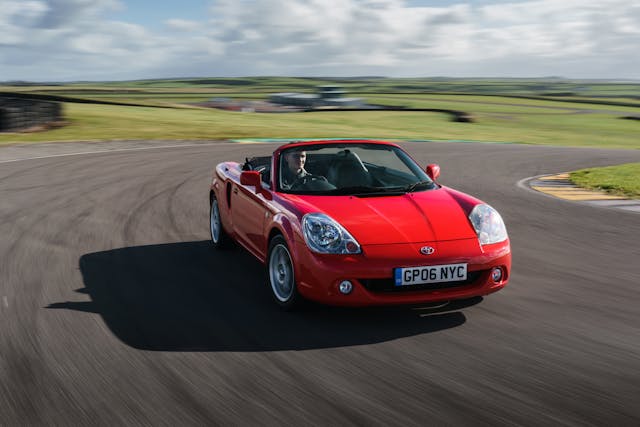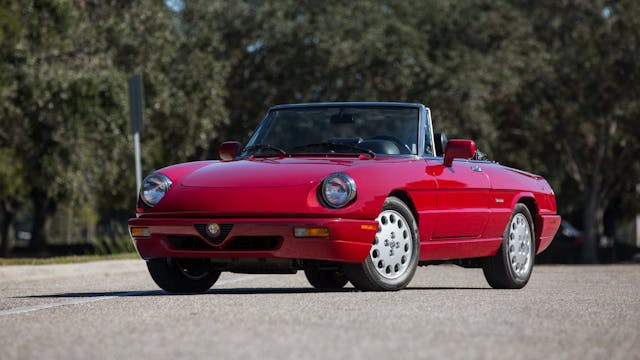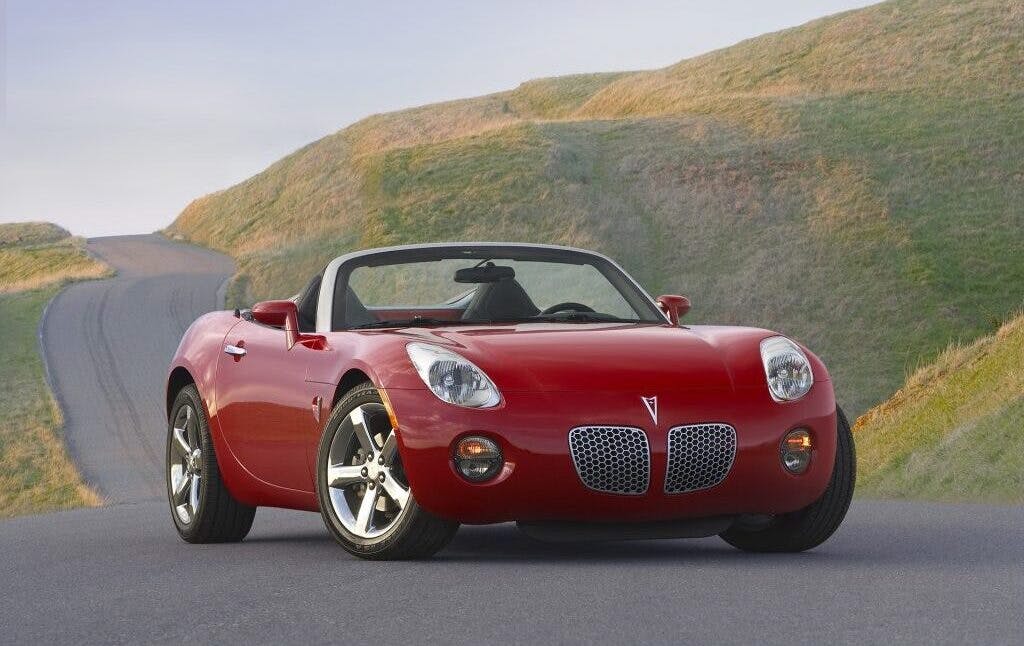For under $25K, these 7 cool convertibles bring fair-weather fun
It’s December now, and for much of the country that means we’re driving with the heater on. Many of us have also put our fun cars away for the winter or are starting to tackle winter projects. It’s never too early to start daydreaming about sunshine and top-down cruising, however, and the two-seater drop-tops below are affordable ways to do it once spring arrives. All are worth under $25,000 in #2 (“Excellent”) condition in the Hagerty Price Guide, but driver-quality examples of each can be found for even less. Which would you pick, or imagine yourself behind the wheel of, when the weather turns warm?
2000-05 Toyota Mr2 Spyder: $20,500

Since Miatas aren’t allowed (we featured them in a recent run-down of popular Japanese collector cars, and everyone knows they’re a viable contestant in this list), why don’t we start with something similar, but then again very different?
In some ways the third (and final) generation Toyota MR2 lives in the shadow of its more interesting, more ambitious predecessors. Taken on its own, though, it offers similar vibe, performance and reliability of the NB (1999-2005) Miata it once competed against. Its 1.8-liter 140-hp four-cylinder has nearly the exact same displacement and power rating as the Mazda, and the two Japanese budget warriors can be had for a similar price.
Then again, the Toyota also comes in a more exotic-feeling mid-engine layout, and because the Mister Two never really caught on (yearly North American sales averaged about one-third of the Mazda MX-5) it’s a relatively rare sight on the road. With its mid-engine mojo and distinctive buggy-eyed face, it’s sort of like a toned-down, more affordable Lotus Elise.
1989-95 Lotus Elan M100: $23,500

Speaking of Lotus (and Miatas), both Mazda and the then-GM-owned British carmaker went into the 1990s with the same idea—basic, affordable English roadsters were long dead, but people would buy one if only somebody would build it. Looking to fill this obvious hole in the enthusiast market, Mazda looked to classics like the MGB and, ironically, Lotus’s own Elan from the 1960s as inspiration. Then they distilled the concept, added Japanese reliability, and drove off into the sunset with what became the world’s best-selling two-seater.
Lotus, however, took a different approach. The new Elan, aka the M100, used a Japanese drivetrain, which was reassuring. With 165 hp from the turbocharged 1.6-liter Isuzu four and a curb weight of less than 2500 pounds, so was performance. But there were two strikes against this new Elan. First was the fact that the Isuzu four spun the front wheels. The Elan M100 has plenty of defenders who will happily tell you how wonderfully it handles, but purists considered a front-drive Lotus just plain blasphemy. Second was the price, which came in at over twice the price of the Miata that launched at the same time. The Elan was significantly faster and came with a much better interior, but it wasn’t enough to justify the cost. Only a few hundred American buyers stepped up for one, so at today’s values they make for a very rare car with a famous premium badge for not a ton of cash.
1986-96 Chevrolet Corvette: $24,600

The C4 Corvette isn’t everyone’s cup of tea, and its values have generally reflected that. But you can’t deny it’s a ton of car for the money compared to the other ’80s and ’90s performance cars that have skyrocketed over the past five years or so.
Technically a C4 coupe is quicker and cheaper than a convertible, and it still offers wind-in-your hair motoring thanks to its removable targa roof panel. Sometimes, though, there’s no substitute for a true drop-top, and C4 convertibles are still remarkably affordable. Aside from the last few model years and special edition models like the Grand Sport or 1995 Indy Pace Car, most L98 (1986-91) and LT1 (1992-96) convertibles can be had for under $25K in #2 condition. If you’re willing to live with some bumps, scratches and miles, however, it gets even better. The #3 (“good”) value for most C4 convertibles doesn’t even push into the teens.
1980-81 Triumph TR8: $23,900

Thinking of a small lightweight English roadster with American-derived V-8 oomph usually brings up the Shelby/AC Cobra or the Sunbeam Tiger. Both of those cars are badass but also downright expensive. There’s another choice, however. One that’s way cheaper and way…wedgier.
In 1975, Triumph started to phase out its old-school TR6 with its body-on-frame construction and wood dash. In its place came the TR7, which was supposed to carry the struggling company into the future. Wedge-shaped cars were all the rage in the mid-1970s, but designer Harris Mann arguably missed the mark with the TR7, which was roundly criticized when new and doesn’t look that great today, either. Early TR7s also had serious reliability issues, and the sub-90-hp 2.0-liter four left them all underpowered. To fix that last bit, Triumph dropped in the all-aluminum 3.5-liter Rover V8 (which traced its roots back to Buick in the 1960s) and christened the new model, naturally, TR8. It was the same basic car, but the much more powerful engine and better build quality were very welcome.
This “English Corvette,” as some called it, was a consistent winner in both SCCA and IMSA racing, while Car and Driver called it “nothing less than the reinvention of the sports car.” But it couldn’t reinvent Triumph. A victim of British Leyland’s collapse in the 1970s and 1980s, the company was defunct by 1984, making the TR8 the last of the traditional British roadsters. Association with the unloved and visually identical TR7 along with the plastic-and-plaid interior kept TR8s cheap for years, and although #2 values are up 52 percent since 2019, these cars still provide good value for the money.
1991-95 Alfa Romeo Spider S4 (base model): $23,400

The original Alfa Spider kept its Italian builders busy for decades, and its 1966-94 production run makes it one of the longest-lasting sports cars ever. It’s also one of a precious few made-in-Italy two-seaters that average enthusiasts can realistically dream of parking in their garage.
The last of the series debuted in 1990 (1991 in the US), and on balance it’s arguably the best of the breed. The looks, chassis, and engine trace their roots straight back to the ’60s, but also featured plenty of upgrades and improvements. In fact, this final generation is sort of like a ’60s classic infused with ’90s comfort and convenience, although some of the older cars’ more interesting quirks were gone. North American buyers could choose from a base Spider or a “Veloce,” featuring luxury add-ons like leather seats, air conditioning, and a cloth top as well as alloy wheels. While Veloce models command a big premium with #2 values stretching past 30 grand, base models come in at a much more tolerable $23,400.
2006-10 Pontiac Solstice/Saturn Sky: $20,700 / $18,600
“Solstice and Sky” sounds like a lady rap duo, but they’re two of the last true American sports cars that don’t read “Corvette” on their tails.
Meant to be home-grown alternatives to the affordable roadsters from Japan, the short-lived Solstice/Sky pair were casualties of GM’s Great Recession bankruptcy. Still, they sold reasonably well when they were around and remain cheap entries into modern roadster fun.
The Pontiac Solstice first arrived for 2006 with 177hp and 166 lb-ft of torque. To bring up the Miata yet again, the Solstice had it beat on grunt, but at 2888 pounds the Pontiac was also several hundred pounds beefier. The interior was also clad in standard early 2000s GM plastic, but the body looked like nothing else on the road, and that’s still the case today. On track it won the SCCA Showroom Stock B and Touring 2 championships, and then in 2007 a hotter Solstice GXP model arrived with 260 turbocharged horsepower and 260 lb-ft of torque as well as a limited-slip diff.
The reskinned Saturn version, called the Sky, arrived for the 2007 model year and its turbocharged variant was called the Redline. All versions of these cars are affordable, but while the Saturn is more conventionally pretty, a Pontiac badge has more cachet than a Saturn one (not a hard thing to do) and is generally worth more. Base Solstices run $16,600 to $19,400 in #2 condition, while a GXP only stretches into the low-20s. The Sky, meanwhile, ranges from $16,400 for a base model to $24,300 for the most expensive Redline.
1997-2004 Porsche Boxster: $22,000

Alas, the “cheap” Porsche is mostly a thing of the past. The 914s, 944s and 996-generation 911s that people used to turn their noses up at have long since gotten respect, and higher price tags as a result. Mercifully, though, the first-gen (986) Boxster, which started at over 40 grand when it was new, has stayed somewhat inexpensive. Sure, it’s not the best-looking P-car, and it has been the butt of many a joke. But you could say the same thing about the 914, and that car’s now twice as expensive as a Boxster.
The 986 is a well-balanced, comfortable, tossable little car. And with one trunk up front and another behind the mid-mounted flat-six, it’s more practical than it looks. In addition to the jellybean styling, the infamous IMS bearing issue tarnished the 986’s reputation a bit, but after two decades many cars have had that issue fixed by now or are unlikely to suffer from it. There are plenty of examples around, and the average #2 condition is $20,800. Stretch the budget a little bit and a Boxster S, which came with a larger engine and over 30 more hp than the base car, sits at just $27K.
***
Check out the Hagerty Media homepage so you don’t miss a single story, or better yet, bookmark it. To get our best stories delivered right to your inbox, subscribe to our newsletters.





Excellent. I’ve found it very helpful. I guess EV’s exceed your price range however.
I guess my comment disappeared,q
hard to go wrong with an alfa spider or a mid 90s vette with an LT1.
lotus elans are near impossible to find.
the 00-05 mr2 imo is still ugly and ruined a still cool looking design from the mid/late 90s version.
the saturn looked better than the solstice but both are just meh
tr7 was always ugly – never understood why my friend’s dad bought one – who always had ‘cool’ cars like tbirds and vettes and such…
like some others mentioned, a 01-06 jag xk8/r is a good one.